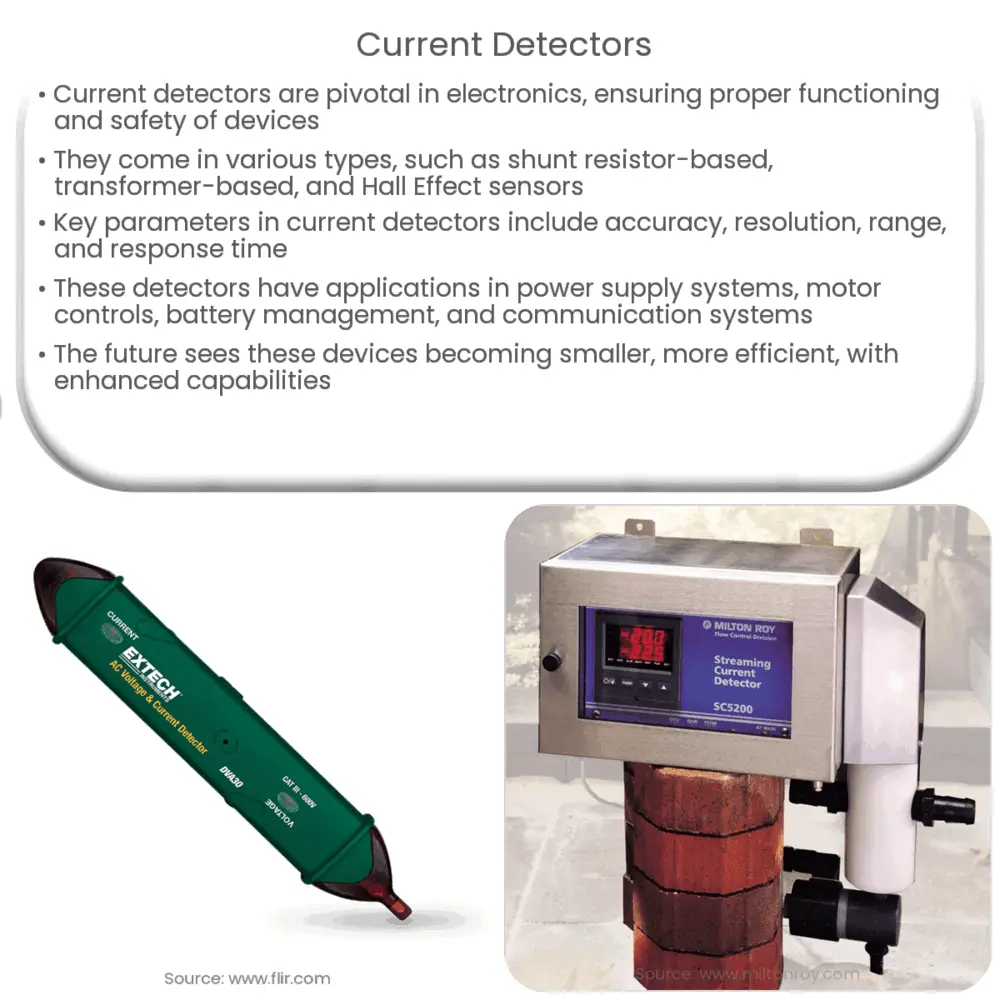Explore the vital role of current detectors in electronics, their types, key parameters, applications, and the future in our detailed guide.

Introduction to Current Detectors
Current detectors play an essential role in the realm of electronics. They are key devices used in many electronic systems to measure the amount of current flowing through a circuit. The fundamental importance of current detection can’t be overstated as it is often crucial to ensure the proper functioning of electronic devices, prevent potential overloads, and maintain the safety of the entire system.
Types of Current Detectors
-
Shunt Resistor Based Current Detectors: This is one of the simplest forms of current detection. In this setup, a known resistance, or ‘shunt’, is placed in the current path. By measuring the voltage drop across this resistor, the current is determined using Ohm’s law.
-
Transformer Based Current Detectors: These detectors use the principle of electromagnetic induction to detect current. A coil of wire is wrapped around the conductor through which the current flows. The change in magnetic field caused by the current induces a voltage in the coil which can then be measured.
-
Hall Effect Current Detectors: The Hall Effect sensor detects the magnetic field generated by the current flow and provides an output voltage proportional to the current. These sensors offer the advantage of isolation from the current path, making them safer to use in high-current applications.
Key Parameters in Current Detectors
-
Accuracy: Accuracy of a current detector refers to how closely the measured value matches the true value of the current. It is often expressed as a percentage of the full-scale reading.
-
Resolution: The smallest change in current that can be detected by the detector is its resolution. This parameter is especially important in applications where fine changes in current must be monitored.
-
Range: This is the span of current values that the detector can accurately measure. It is typically given by a minimum and maximum value, for example, 0.1 A to 10 A.
-
Response Time: The response time of a current detector refers to how quickly the device can respond to changes in the current. In applications where the current changes rapidly, a detector with a short response time may be necessary.
Applications of Current Detectors
Current detectors find applications in a wide variety of fields, a few of which are outlined below:
-
Power Supply Systems: In power supply systems, current detectors are used to monitor and control the output current to ensure stability and safety.
-
Motor Control Circuits: Current detectors in motor control circuits protect the motors from potential damage caused by overcurrent conditions. These detectors trigger a protective mechanism when an overcurrent situation is detected.
-
Battery Management Systems: In battery management systems, current detectors monitor the charge and discharge current to prevent overcharging or excessive discharging which could harm the battery’s lifespan.
-
Communication Systems: In communication systems, particularly in RF (radio frequency) applications, current detectors help in power control and diagnostics.
Future of Current Detectors
With the advent of new technologies and increased demand for electronic devices, the future of current detectors looks promising. The evolution of these devices is headed towards improved accuracy, higher resolution, and faster response times. Particularly, there’s a growing trend towards integrating current detection functions in smaller, more efficient chips, which will further enhance the versatility and convenience of these devices.
Conclusion
Current detectors are integral to the smooth functioning of countless electronic systems. They not only monitor and maintain the stability of these systems but also ensure their longevity and safety. Understanding the principles of current detection, the different types of current detectors, their key parameters, and their widespread applications can provide a comprehensive insight into these essential components. As technology advances, we can expect to see the capabilities of current detectors continually expanding, leading to even safer, more reliable, and more efficient electronic systems.

